Welcome to a very special guest post of Make A Thing! Here, we make handmade gifts for people! Or ourselves. Or our cats. Mostly our cats.
Header by Rory Midhani
(Based on Anna’s wildly popular presentation at camp about terrariums, I cornered her and begged her to write up a how-to on making one! I love it and I can’t wait to share it with all of you! Enjoy! – Hansen)
Terrariums! So, depending on your level of Etsy-savvy, you may be well aware of the general idea behind tiny gardens in containers. If not, don’t worry! I’m about to catch you up to speed and have you busting out THE MOST memorable gifts and home décor your shiny queer hearts can handle.
A terrarium is a plant or grouping of plants arranged and maintained in a pleasing, mindful way in a container. It serves as a sort of balancing act between small-scale botany and aesthetics. The discovery of this idea is, according to My Research, credited to an English bro named Nathaniel Ward. He was around in Industrial-revolution era London, and he had a lot of plants, but the happiest ones were in their own semi-enclosed environment, kicking it without all that Capitalist Pollution. Fast forward a few centuries, past that depressing bit where Imperialists totally taint the earthy glow of this technological discovery by using it to bring back and cultivate Colonial flora (seriously they ruin everything); fast forward through the 1970’s when, for some reason, terrariums became so popular they were included in cereal boxes, and your terrarium time machine will deposit you in this current, third wave (!) of container gardening popularity. It’s fitting, really, when you consider our generational interest in science, our environment, and climate regulation. We are also more likely to find ourselves living in apartment spaces or rental properties with little, if any, outdoor green space.
SO. Let’s make a thing!
Terrarium From Outer Space
The first thing I would do (but this is ART so YOU DO YOU) would be to choose a theme. You could go about this using, perhaps, an abstract image you have in mind of a fabulous little Harajuku world with tiny plastic ice cream cones used as tiny little planters. Or maybe you just went estate-sale-ing, and you came across the creepiest Addams family (whattup, Carly and Robin) glass birdhouse type thing. Or maybe you found a really wild-looking cactus you’d like to showcase. Or maybe you’re like me and a bit obsessed with space-y things and you wonder what it’d be like to terra-form on the moon so you want to make a tiny bio-dome. In any case, your theme will help you decide on how your components will fit together.
Here is a tiny list of possible themes I may or may not have used: Traditional Victorian Garden , ‘Rustic’, Seaside, Desert, Rainforest, Woodlands, Asian, Wizard of Oz, Alice in Wonderland, Harry Potter, pretty much anything ever.
A terrarium can be broken down into four major components:
1) Container
2) Base
3) Plants
4) Ground Cover and Decoration
Container:
What you want to look for in a container is clear glass that’s mostly enclosed or can be enclosed. The mostly enclosed part is key, because this will maintain your tiny ecosystem’s tiny carbon and water cycles. The degree of enclosure will inform what kind of plants will do best in that container. For example, cacti and succulents will need far less moisture than ferns or mosses, so a more open container will allow for more evaporation and will be less likely to drown your plant babies. So choose your container in keeping with this consideration, too. Aside from that, the possibilities of containers are nearly endless: mason jars, light bulbs, spice jars, glass frame birdhouses, geometric glass cubes/pyramids, apothecary jars, old cookie jars, fishbowls, lanterns, cloche jars. Both Target and Fab had really cute wall-mounted ‘fishbowls’ that are obviously way too tiny to house any fish humanely but would be ideal for a terrarium, for maybe $25? It was last year when I found them but I’m sure somewhere on the internets that’s still a thing.
For my space terrarium, I used a more traditional terrarium container, with a cloche type dome and a glass base and an ashtray and an inverted clear cylinder vase for the biodome.
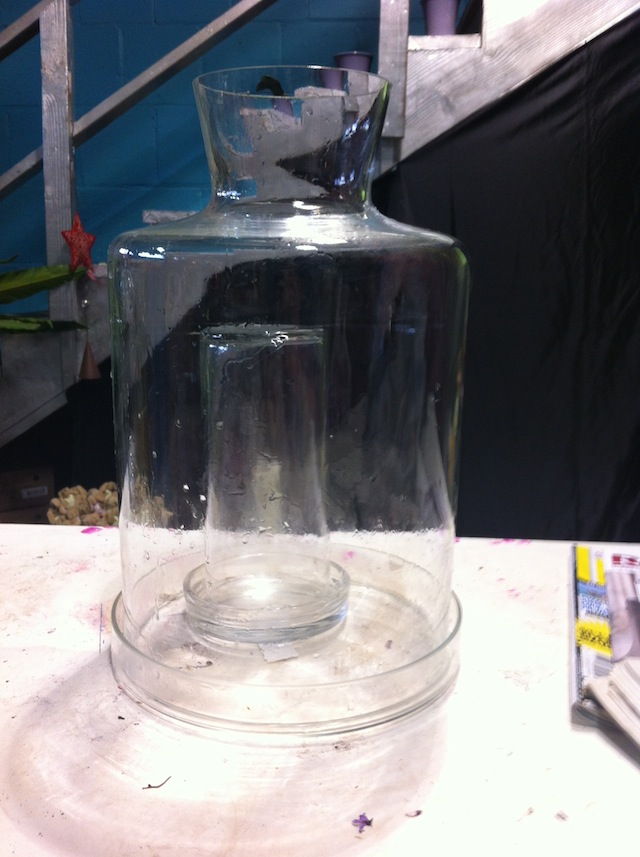
Base:
Your base is where your plants live. It should take up approximately one-fourth to one-third the entire interior of the container. It’s comprised of three parts: a drainage layer, some charcoal, and some soil.
The drainage layer gives the water in your terrarium a place to go so it doesn’t rot out the roots of your plant or cause mold or anything else gross and potentially plant-fatal. Pea gravel is really simple and, I think, looks really classic and maybe sort of too traditional but it’s whatever, I like it, and, art. Or something. Anyway, you can also use rocks you’ve collected from your travels (maybe your time on Mt Feels), sea glass, sand, marbles, sea shells, gold flake has worked really well for me, you can even use moss (but I’d recommend preserved, and not-dyed because those colors get WEIRD after they sit in water for a while). The point is, you want to keep the roots dry, and make the foundation a bit fancy.
Next up is charcoal. You add charcoal to keep the soil fresh and releasing nitrogen over time, and to introduce carbon to your carbon cycle, hey! You can buy charcoal soil conditioner from most gardening places, Amazon has it for anywhere from $6-$15. You’ll want to use a bit less for drier-footed plants and a bit more for fern-types. Make it a bit ground up in your hand, and for most terrariums, you won’t need more than a small handful. Create a thin layer on top of the rocks and you should be fiiiiiine.
Next is soil. Regular potting soil is fine for most terrarium plants, but there’s specialty stuff available dependent on the type of plants. Succulent mix is probably the most popular kind, it’s mixed with some sand and gravel to provide extra drainage to the roots. Add in the soil, maybe two to three fingers high on the base (you guys have no idea how hard it is for me to not make these most obvious of jokes when I’m actually teaching this class). Some people recommend adding a layer of moss between the charcoal and soil, to prevent the soil from getting watered down and mucking up the rocks. Sometimes the mucking of the rocks is an issue, sometimes it doesn’t happen. Terrariums can be such great metaphors for life, guys.
Plants:
Things to keep in mind when you select your plants:
- container size- because you don’t want to overcrowd the roots or leaves in an environment where condensation could cause rot.
- how enclosed your container is- ie ferns will do better in a less-open environment.
- placement- plant your largest plant first to ensure proper spacing.
- condition of plant baby- be sure to remove any dead or dying leaves and to check for mold or bugs.
When you actually plant your little babies, you’ll take them out of their tiny plastic pots by squeezing the sides and gently pulling at the base of the plant. Next, you’ll want to clear the old soil off their roots. Aside from giving the plant baby a literal fresh start, the opening of your container will likely require a smaller object than what comes in said tiny plastic pots. You can remove the soil from the roots with tiny tweezers (I got some really fancy ones at Paxton Gate), tiny paintbrushes, bonsai rakes, even a set of chopsticks has been of aid. Just try to keep the roots mostly intact, and mostly free from their old soil. Once the roots are mostly clean, start to gently wrap them around the base of the plant. Add a bit more of the new soil, and try to create a fairly compact root ball, maybe about the size of a cherry tomato.
Create a hole in the soil, slightly larger than the root ball, and about a half-inch deeper. Drop your little plant baby in its new home, and tuck it in. I find the easiest way to do this is to hold the plant in place with a chopstick or some sort of tool, then use some type of funnel (usually folded craft paper) to add in some soil around the base, then gently pack the soil in using the other chopstick/ paintbrush/ tiny rake/ whatever.
For my space terrarium, I had to make the base into more of an anthill shape to get it to fit its container. Sometimes hilly bits just look cool, so try that out if you want!
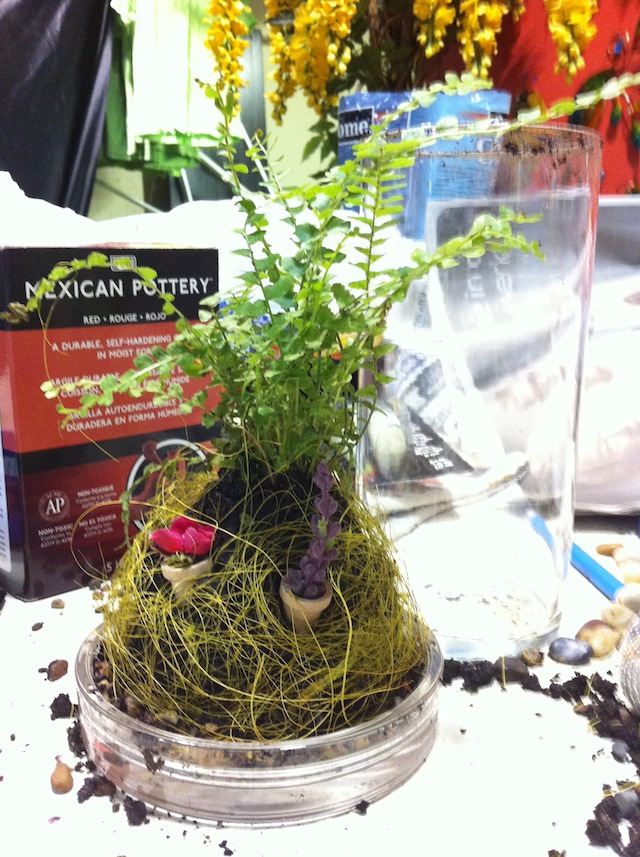
**The part where you actually handle the plant materials is the part I find most satisfying. A lot of things in our lives are so distracting, so fleeting, so momentary and so disruptive. Creating a micro-climate is a chance to practically go to another world. You don’t have to think about your stupid ex or your laundry or how loud your neighbor’s dog is or that rude thing that person on the bus said or how we’re all going to die someday or how you really aren’t doing anything with your life at all and OMG is all of this just a huge waste of your time? None of this matters or comes up because your hands are dirty; they are occupied with the very fate of another living being. The smell of growth and renewal is encompassing. This world gets to be exactly how you make it and there’s no right answer. It’s incredibly comforting and meditative. Get into it.**
Ground cover and Decoration:
Ground cover is mostly referring to moss. This not only looks pretty and complements the visual texture of your plants, but it can help keep moisture in the soil if you discover your plants to be particularly thirsty. You can also use sand or decorative rocks or marbles or something so clever I haven’t even thought of it yet. Get creative here, gaybies! Or you can be super minimalist with it and include a tiny piece of lichen moss next to your plant if that floats your boat.

Once ground cover is down, you can add as many decorations as you want. Generally, your theme will dictate to a certain degree the kinds of things that can be included. Desert scene? Throw in some tumbleweeds or a tiny skull. Seaside theme? I used seashells and clay miniature sea turtles in mine. It was ADORABLE. And GUESS WHAT I included in my space terrarium? A tiny space ship. Your decorations don’t need to be miniatures, though. Natural elements are just as beautiful in a million different ways. You can use feathers, sea shells, rocks, interesting sticks, cicada shells, anything. My only cautions would be: not to overcrowd your plants so that their leaves make contact with the sides of the container (this will cause those leaves to rot), and don’t use stuff with lots of dye in more enclosed, wetter containers because it will either dye your plants wacko colors or kill them. Otherwise, run wild with it, you beautiful unicorns.
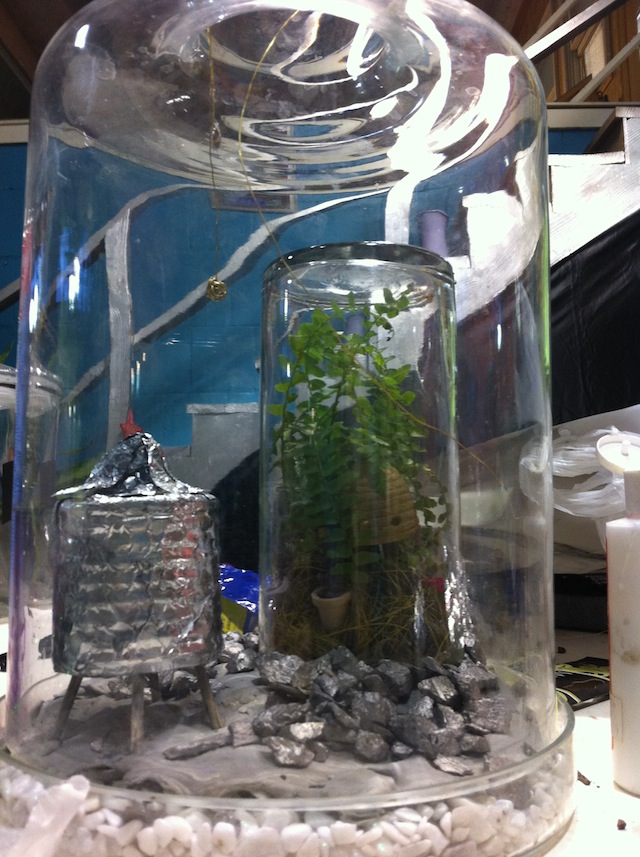
Now you’ve got your beautiful terrarium all put together, yay! In terms of maintenance, you really only have one major concern: water. You can never un-water a terrarium. Unless you’re like, master of tiny siphons. In that case, come teach classes with me. Otherwise, you want to take great care to make sure you don’t overwater. Start with a shot glass of water, once a week. If, on that schedule, you see a little condensation, it feels warm inside the container, and it smells like earth, you’re doing great. It might take a little more or a little less, but you’ll figure it out. In addition, consider the amount of natural light your terrarium will get. Ideally, terrariums prefer bright, natural light that’s not too direct. Too much direct sunlight will create a tiny oven and cook your plant babies. You also want to make sure you trim off any dead stuff (if you can) to prevent mold or bacteria.
This is the space terrarium, all finished:
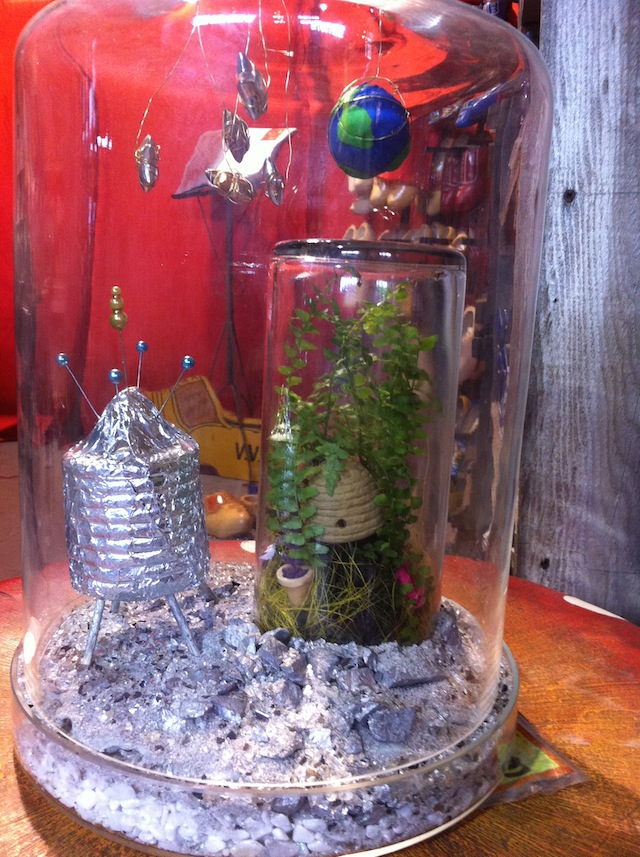
Lastly, make sure you spend some time looking at the thing. Don’t just glance at it in passing, but think about it. Think about growth, think about renewal. Think about where you were last week and how you and your terrarium have changed (however microscopic that change may seem). Think about being present and the understanding that there’s no right way to grow. Smell some dirt. Enjoy!
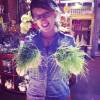 Anna Asteroid was reportedly first observed arranging flowers on nearby Alpha Centauri around 5600 BCE. She has designed for over 9000 weddings and one divorce. When she’s not at her home base, Dutch Flowers, in Kansas City, MO, you can likely find her baking things with her diva bitch of a cat, Tuesday.
Anna Asteroid was reportedly first observed arranging flowers on nearby Alpha Centauri around 5600 BCE. She has designed for over 9000 weddings and one divorce. When she’s not at her home base, Dutch Flowers, in Kansas City, MO, you can likely find her baking things with her diva bitch of a cat, Tuesday.


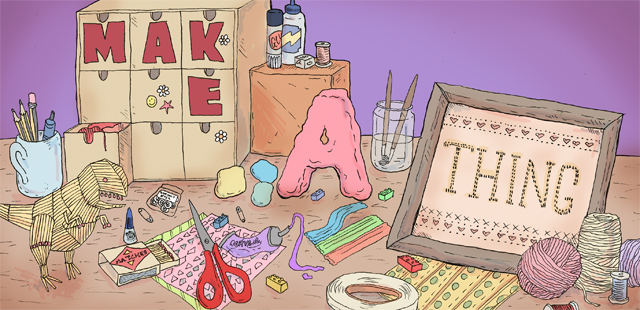

I have noon trying to figure out how to make terrariums since I left camp I have a v v happy queer right now!!
ANNA I love you and your space terrarium!
I recently watched Oblivion, and your small patch of abundant plant life among the sparse, desert-y space ruins reminds me really heavily of the imagery in that movie. (But your terrarium is so much better, obviously, because it doesn’t include “sexy lamp” women whose only purpose is to further the male lead’s character development.)
xoxo
LAURA! HEY GIRL HEY! love dovey! Definitely must watch this Oblivion now. for science reasons. definitely not for sexy lamp reasons.
Wait I have so many questions!
How do you water it, do you lift the inner vase off the plant?
How did you get the pile of soil to stay in a hilly mound like that?
What happens when your plant gets too big for the container?
I has answers for youu! That particular terrarium has not been watered since I put it together in mid-april. I watered the base of the plant before and after I made it into a root ball, and because it’s such a small space, i guess, it condenses and rains on the tiny fern pretty quickly. plus there’s charcoal in there and that helps. i don’t know what will happen when it gets to big but i promise to take pictures!
omg the lunar lander argghghgh the cutest i can’t handle it agh. wonderful, thank you.
Oh my God, this is the best article eveeeeeer! Loved the life lesson, you never know where those are gonna come from.
INSPIRATION! I’ve been wanting to do something like this since the summer. I think my time has come. Soooo cute.
I AM SO PROUD OF YOU MY GOSSIP DAUGHTER
Anna, you’re my favorite. I can’t wait to try making a terrarium again.
plant babies!